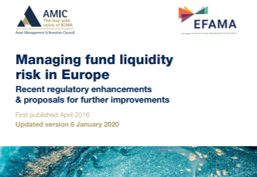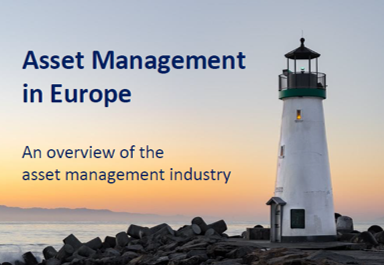EFAMA welcomes ESMA’s Call for Evidence on asset segregation and custody services as a precious occasion to confirm our previous key messages - as per our response to the previous consultation around Guidelines on asset segregation under the AIFMD of December 2014 – and to clarify our position on new aspects of ESMA’s work.
EU Fund regulation
The EU fund product landscape is deep, diverse and dynamic. Since the birth of the UCITS framework in 1985, European institutions have progressively refined it into a global “gold standard”, one that successfully balances strict regulatory requirements with the flexibility required by manager to meet evolving client demands. The successful evolution of UCITS was followed by the creation of alternative investment funds (AIFs) under the 2011 AIFM Directive, adding a second important pillar to EU fund/manager regulation. Building on this second pillar are further ambitious EU fund products, such as EUSEFs, EUVECAs and ELTIFs. EFAMA has helped guide all of these key regulatory developments, informing policymakers and regulators on their main merits and drawbacks, while also keeping a close eye on their respective review initiatives.
EFAMA strongly supports a fundamental review to the ELTIF regime, in view of broadening its eligible investment universe and adapting it to better meet retail investor needs. We are also closely monitoring the review of the AIFM Directive from a product regulation standpoint, including possible spillover effects on the UCITS Directive requirements. Further work involves keeping pace with relevant ESMA initiatives, such as the work around the Common Supervisory Action on costs and fees for UCITS.
EFAMA response to ESMA Call for Evidence on asset segregation
EFAMA response to Green Paper on Retail Financial Services
EFAMA welcomes the opportunity to respond to the European Commission’s Green Paper on retail financial services. Widening the opportunities for European citizens to save and invest will facilitate better outcomes both for savers and the wider European economy.
EFAMA fully shares the goals of a Single Market for retail financial services in the EU, i.e.:
1. Promoting an EU-wide market in retail financial services that can facilitate cross-border business and consumer choice.
EFAMA response to EC consultation on impacts of maximum remuneration ratio under CRD IV
Our corporate members are both subsidiaries of an EEA parent that is a credit institution as per Article 4(1)(1) of the CRR, or stand-alone investment firms as per Article 4(1)(2) of the CRR. Both types of entities risk becoming subject to the Maximum Ratio Rule as asset management companies licensed under either a UCITS or AIFM management company license, or licensed as investment firms under the MiFID regime to provide discretionary portfolio management services on a client-by-client basis.
EFAMA reacts to IOSCO statement on liquidity risk management for investment funds
EFAMA welcomes the recent statement by Ashley Alder, IOSCO Board Chair, on liquidity risk management for investment funds.
Liquidity and counterparty risks in ETFs
EFAMA recently finalised a  Comment Paper in response to the ECBs November 2018 findings around liquidity and counterparty risks in ETFs, included in the ECBs semi-annual Financial Stability Review.
Comment Paper in response to the ECBs November 2018 findings around liquidity and counterparty risks in ETFs, included in the ECBs semi-annual Financial Stability Review.
EFAMA welcomes final agreement on legislation facilitating cross-border distribution of funds
We welcome yesterday's vote by the European Parliament plenary, formally adopting the trilogue agreement on the Commission's initiative to remove cross-border barriers to the distribution of investment funds.
This marks a decisive recognition of the need to postpone the application of the PRIIPs disclosure regime for UCITS by two years, in light of the regime's documented shortcomings. It also allows the European Commission more time to conduct a thorough review of the same within one year.
EFAMA Market Insights | Issue #1 | Net outflows from UCITS in March 2020 - Industry weathers Covid-19 crisis
The Covid-19 pandemic significantly impacted financial markets. Stock markets across the world suffered a steep decline driven by lower economic growth and corporate profits. As anticipated, the crisis caused substantial net outflows from UCITS in March (EUR 313 billion). However, as a percentage of net assets, these outflows were no higher than in October 2008, at the height of the global financial crisis (2.9%).
AMIC EFAMA Report - Managing fund liquidity risk in Europe - 2020
In 2019, AMIC and EFAMA decided to update their 2016 report “Managing Fund Liquidity Risk in Europe” following important policy and regulatory developments at EU and international levels. The purpose of this updated report is to outline the practical liquidity risk management processes which fund management companies put in place when setting up a fund and implement throughout the life of the fund. Also, the report describes the existing European and international regulatory frameworks in the area of fund liquidity risk management.
Asset Management Report 2019
The EFAMA Asset Management in Europe report aims at providing facts and figures to gain a better understanding of the role of the European asset management industry. It takes a different approach from that of the other EFAMA research reports, on two grounds. Firstly, this report does not focus exclusively on investment funds, but it also analyses the assets that are managed by asset managers under the form of discretionary mandates. Secondly, the report focuses on the countries where the investment fund assets are managed rather than on the countries in which the funds are domiciled.































